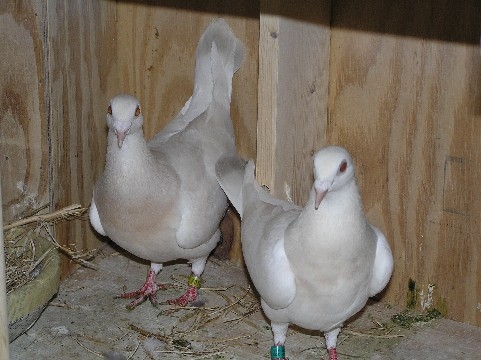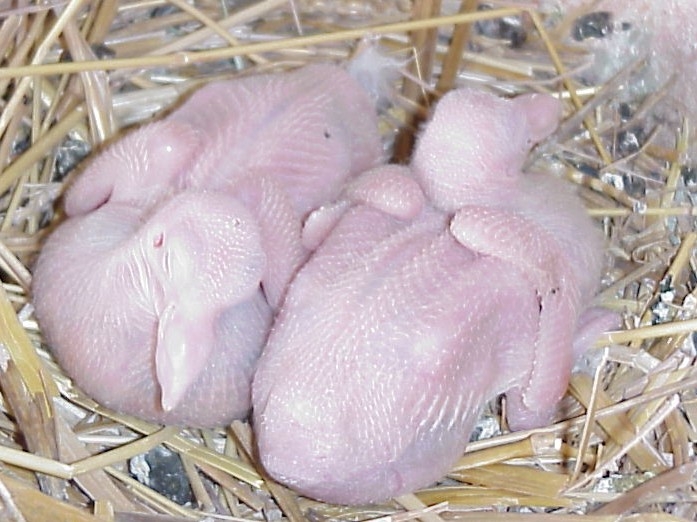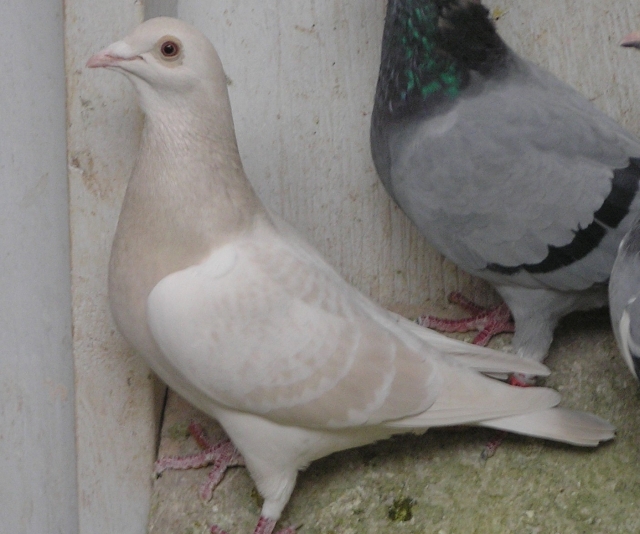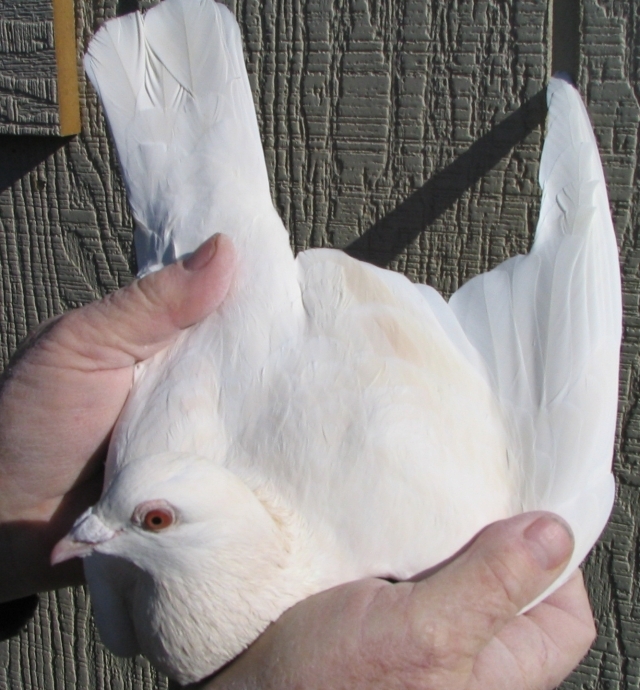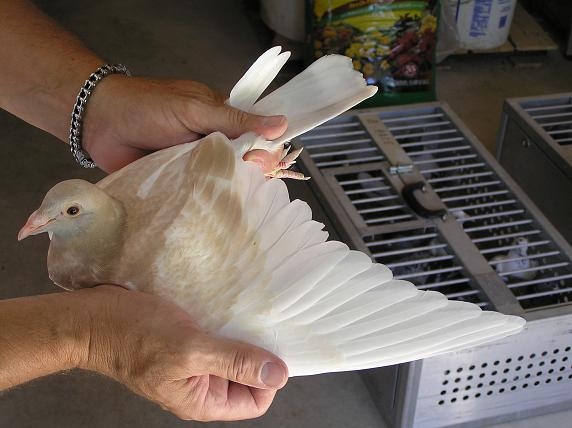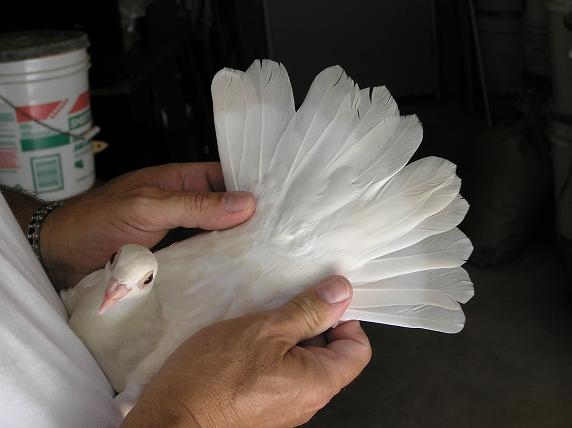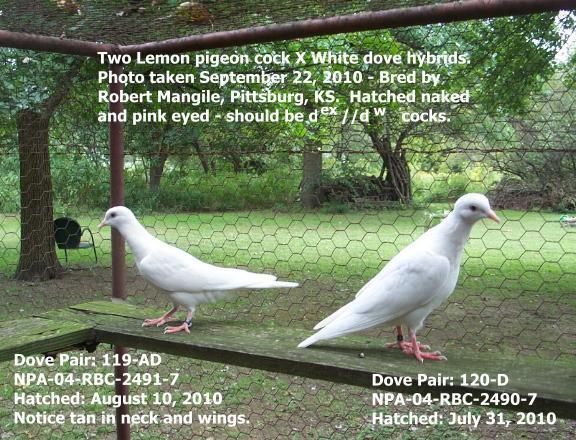with
one lemon pair going to one loft, 3 lemon cocks each going to separate
lofts and the remaining 6, 3 heterozygous cocks and 3 lemon hens, all
going to the fifth loft. Many of these 11 birds were destined to be the
"seed stock" for the research into extreme dilute in the US and formed
the first importation into the US of this new mutation.
Unfortunately these birds
were held in transit and quarantine until very late in 2002 and when
delivered were in very rough condition it was reported. The loft
receiving the largest number from this shipment reported that the
majority could not be successfully bred until relatively late in 2003
due to the condition problems as well as becoming acclimated to the
northern hemisphere.
Genetic testing became
organized in South Africa in early 2004 by a group of like minded
fanciers on the South Africa Pigeon Mailing List or SAPML for
short. Larry Davis was one of these fanciers but since no
Lemon birds had been acquired by him yet, Larry was limited to an
advisory role for the group, the majority of which had little to no
genetic experience. Larry’s genetic experience was
exactly what they needed to get the ball rolling and Dr. Win Peters a
South Africa veterinarian asked Larry to take that roll which he gladly
did.
Now in case your not well
versed in genetics, let me point out, there are certain basic
principles which must be rigidly followed when collecting
data. One of these is good record keeping and another is
controlled breeding tests where there can be no question of who the
sire and dam are. Another rule is keep it simple so that
nothing is added that will cloud the issue and confuse the outcome.
It
was apparent from the get go that some of these rules were not being
followed as conflicting data was being submitted to the
group. To over come this Davis set out some basic guidelines
emphasizing the need for isolation breeding pens and good record
keeping. He laid out some controlled breeding tests to be
conducted and evaluated their outcomes.
The
early findings seemed to indicate that this was a sex-linked recessive
mutation. Now there really aren’t very many
possibilities in this regard as every gene is either a sex-linked gene
meaning it’s located on the Z or sex chromosome or it is not
a sex-linked gene; making it an autosomal gene found on one of the 40
some pairs of autosomal chromosomes. In other words, either
it is or it isn’t sex-linked and if its not sex-linked then
it must be an autosomal gene on an autosomal chromosome.
In
a similar fashion, a gene is either recessive or dominant in
nature. If dominant then it will show it’s presence
regardless if it is heterozygous meaning split for the effect or
homozygous meaning pure. The easy thing to remember is that a
recessive gene will not express when there is a more dominant allele
(alternative) present.
Historic
data from South Africa lead to the hypothesis that lemon was most
likely a sex-linked mutation based upon sex ratios and numbers in the
initial breeding data.
So
the two basic questions before the group were, is it sex-linked or not;
and is it a dominant or a recessive? Larry’s
prescribed breeding tests gave them the answers.
Using
Larry’s guidelines, the pairing of lemon hens with the
un-related blue cocks the youngsters produced were all blues of both
sexes. However, when breeding their blue sons to their blue
sisters or to other un-related blue hens, some lemon youngsters could
be produced and these were always hens; all of the remaining youngsters
being blue of both sexes.
In
addition, when breeding the blue sons to lemon hens, both blue and
lemon young of either sex were produced. This clearly
indicated that the mutation was both sex-linked and
recessive. In other words, it seemed to follow precisely the
same rules that govern both dilute and or reduced birds which are also
the result of sex-linked recessive genes.
Also
when pairings were made with lemon cocks to unrelated blue hens all of
the daughters were lemon in color while all the sons were blues. This
would not be possible if this recessive mutation were autosomal.
If
this lemon expression were the result of an autosomal factor,
distribution of the phenotypic lemon expression should have approached
a 50/50 sex ratio which it did not. That strongly
points to it not being an autosomal genetic trait.
Additional
test mating were still needed to achieve the numbers necessary for
positive confirmation but there was more than enough data there to give
Larry and the group a strong indication of what they were dealing
with. Now the big question was “is this a new color
or is it a new color modifier like dilute and reduced.
On
the morning of 5/13/04 there was a posting on the SAPML by Dr. Peters
informing the group that a brown cock to a lemon hen had produced brown
daughters and blue sons. Independent US sources conducting similar
lemon testing yielded these vary same results. To the average flyer
that would seem unimportant but to the armature geneticist like Davis
it was a very significant find. Many had assumed lemon was a
phase of brown while others believed it to be a new pigment.
Dr. Peters posting both eliminated lemon from being a phase of brown or
a new pigment color like brown, blue/black or ash red. The
lemons were breeding as blues.
In
other words, it was not a new phase of brown or a mutation at the b
locus. Davis then concluded he was either dealing
with a new pigment reducing mutation at a new locus on the Z chromosome
or a new allele at one of the existing loci on this chromosome such as
the dilute or reduced loci.
In
May 2005 Davis attempted to demonstrate where on the sex chromosome
this gene may be located. To do this he choose a lemon cock,
which by this time had been determined genetically to be a blue and
paired him to an ash yellow hen.
Since
this was a sex-linked mating (blue cock x ash red hen) he knew the
sexing of the young could be determined by their color while still in
the nest.
Because
we already understand the workings of a sex-linked pairing and what
these results should be; this very useful knowledge then presents us
with three possibilities:
- First,
if the sons were ash reds then this mutation was not at the d locus
(dilute) and additional testing would indeed have to be conducted to
determine its true location.
- Secondly,
if the sons were ash yellows then neither of their two Z sex
chromosomes could have a wild type allele at the d locus for the
dilution effect to be expressed as a single factor for wild type would
have resulted in ash red sons and not ash yellow. If ash
yellow males occurred, it would positively demonstrate dilute and this
lemon mutation would in fact be an allele and some form of dilution.
- The
third possibility would be if the sons were ash lemons then sexing
would have to wait until the presence or absence of the tail bar could
be ascertained and then later confirming breeding tests could be
conducted. This possibility would be if lemon was an allele of and
dominant to dilute.
It
was the second possibility that occurred. Two consecutive nests
produced a blue lemon hen and an ash yellow cock. In
addition, this also demonstrated that dilute was dominant to this new
mutation making it the third allele in the dilute series at the d locus.
The
resulting progeny from the above breeding tests and those from 2004
were handed out both locally and to others mainly at the Louisville
National Young Bird Show (NYBS) in October 2005.
That year, at the NYBS the test pairings and their findings were
discussed in detail with several genetic knowledgeable fanciers,
including those new "lemon owners".
Larry
was convinced that the fastest way to generate more data was to freely
distribute lemon birds to other genetic minded breeders. He
felt if he could get them involved they would be a tremendous asset in
generating more solid data and help to document lemon crossover
phenotypes with both ash red and brown should either occur.
The more duplicating results at differing locations the better. 2006
saw many more being handed out to yet more fanciers in order that more
enthusiasts could become involved.
This
he did and now the quest is on to unravel the secrets of this new
sex-linked, recessive
mutation at the dilute locus. Ron Huntley is working with a
possible ash red crossover as well as a combination of extreme dilute
with recessive red. Both Larry Davis and Larry Long are
working with brown for a possible crossover. Since we know
that a crossover at this locus is approximately 40%, it
shouldn’t take very much longer to produce these new
phenotypes.
Other
fanciers are doing the same around the country, some to produce new
color phenotypes and other to move extreme dilute into other pigeon
breeds.
As
Dr. W. Hollander had predicted we had found a new "extreme-dilute
mutant" at the d locus. And as he had predicted it
caused a phenotype that, at least for the first couple weeks of it's
life, is so de-pigmented as to appear near white with pink
eyes. In summation,we now know that what was up until this point referred to as lemon by most, is a sex-linked recessive at the d
locus and is recessive to both pale and
dilute. Genetically it functions as an
extreme form of dilution and therefore should, as one of the alleles at
that locus, be know as "extreme dilute" and symbolized as dex.
What
started a few years ago with just a few fanciers and a handful of birds
has grown to the point where there are dozens of fanciers all over the
country breeding extreme dilutes and many are transferring this new
modifier into their favorite breeds and at the same time generating
volumes of additional data.
